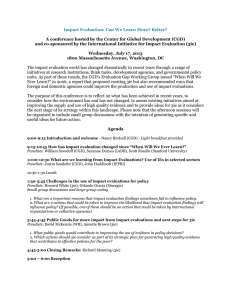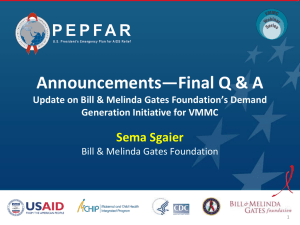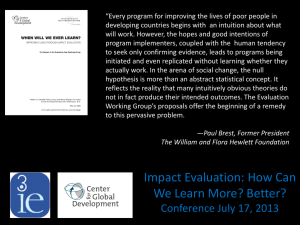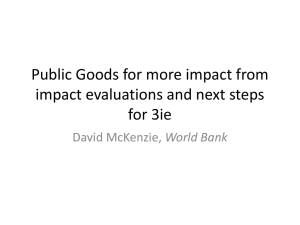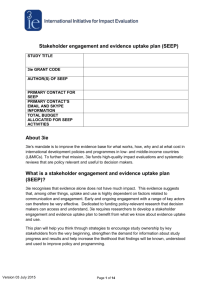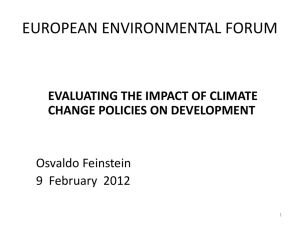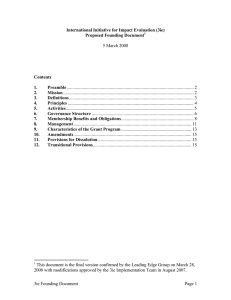M R D N
advertisement
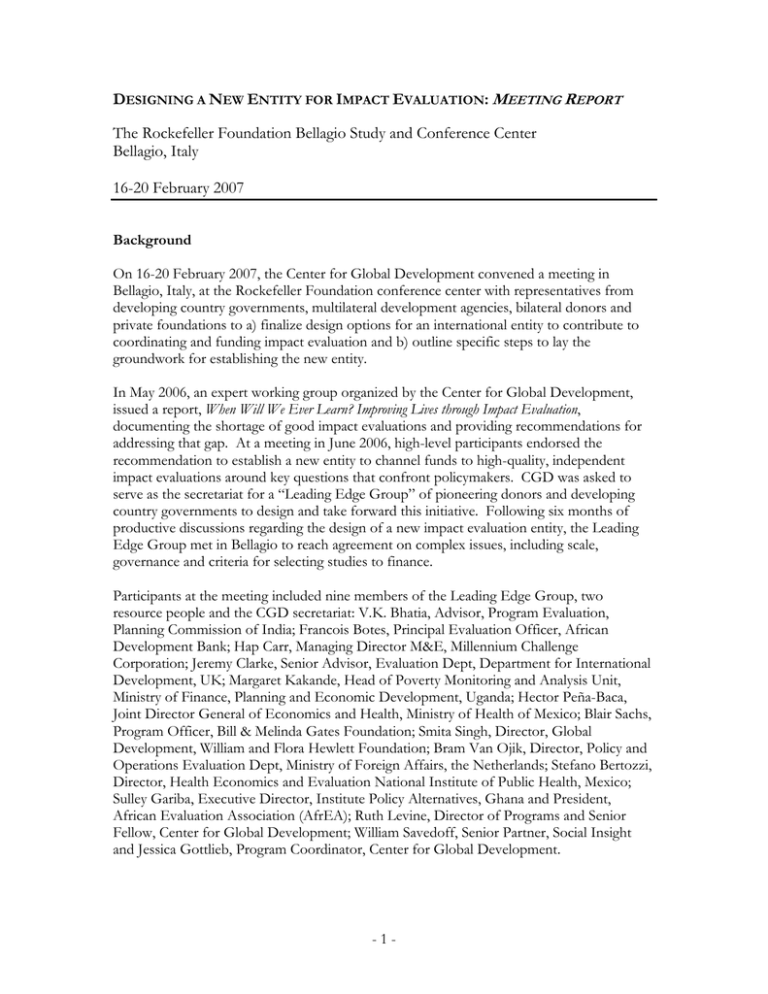
DESIGNING A NEW ENTITY FOR IMPACT EVALUATION: MEETING REPORT The Rockefeller Foundation Bellagio Study and Conference Center Bellagio, Italy 16-20 February 2007 Background On 16-20 February 2007, the Center for Global Development convened a meeting in Bellagio, Italy, at the Rockefeller Foundation conference center with representatives from developing country governments, multilateral development agencies, bilateral donors and private foundations to a) finalize design options for an international entity to contribute to coordinating and funding impact evaluation and b) outline specific steps to lay the groundwork for establishing the new entity. In May 2006, an expert working group organized by the Center for Global Development, issued a report, When Will We Ever Learn? Improving Lives through Impact Evaluation, documenting the shortage of good impact evaluations and providing recommendations for addressing that gap. At a meeting in June 2006, high-level participants endorsed the recommendation to establish a new entity to channel funds to high-quality, independent impact evaluations around key questions that confront policymakers. CGD was asked to serve as the secretariat for a “Leading Edge Group” of pioneering donors and developing country governments to design and take forward this initiative. Following six months of productive discussions regarding the design of a new impact evaluation entity, the Leading Edge Group met in Bellagio to reach agreement on complex issues, including scale, governance and criteria for selecting studies to finance. Participants at the meeting included nine members of the Leading Edge Group, two resource people and the CGD secretariat: V.K. Bhatia, Advisor, Program Evaluation, Planning Commission of India; Francois Botes, Principal Evaluation Officer, African Development Bank; Hap Carr, Managing Director M&E, Millennium Challenge Corporation; Jeremy Clarke, Senior Advisor, Evaluation Dept, Department for International Development, UK; Margaret Kakande, Head of Poverty Monitoring and Analysis Unit, Ministry of Finance, Planning and Economic Development, Uganda; Hector Peña-Baca, Joint Director General of Economics and Health, Ministry of Health of Mexico; Blair Sachs, Program Officer, Bill & Melinda Gates Foundation; Smita Singh, Director, Global Development, William and Flora Hewlett Foundation; Bram Van Ojik, Director, Policy and Operations Evaluation Dept, Ministry of Foreign Affairs, the Netherlands; Stefano Bertozzi, Director, Health Economics and Evaluation National Institute of Public Health, Mexico; Sulley Gariba, Executive Director, Institute Policy Alternatives, Ghana and President, African Evaluation Association (AfrEA); Ruth Levine, Director of Programs and Senior Fellow, Center for Global Development; William Savedoff, Senior Partner, Social Insight and Jessica Gottlieb, Program Coordinator, Center for Global Development. -1- Two Leading Edge Group members who had hoped to attend but were absent expressed continued support for the forward progress of designing and launching a new entity: Mari Pangestu, Minister of Finance, Indonesia and Goberdhan Singh, Director, Evaluation Division, Canadian International Development Agency. The Bill & Melinda Gates Foundation, the William and Flora Hewlett Foundation, and the Rockefeller Foundation provided both intellectual and financial support that was invaluable to the success of the meeting. This meeting report is not intended to be a complete record of the rich discussion over three days. Rather it aims to document the main points raised and the key conclusions. After discussing many alternatives, participants provisionally named the new entity for impact evaluation, the “International Initiative on Impact Evaluation (3IE).” The entity will be referred to as 3IE in the remainder of the document even though this is only a provisional name. Findings A new entity for impact evaluation has the potential for major impact. Participants discussed their hopes and expectations for what an independent, collective initiative on impact evaluation could accomplish. With new evidence generated about what works in social and economic development, policymakers would be better able to use scarce resources effectively and demonstrate to their constituents the reasoning behind policy and program design. Increased funds and advocacy for impact evaluation will add to existing efforts by encouraging more baseline measurement and by enhancing the potential to learn from new and existing development programs. The resources devoted to impact evaluation would be kept separate from the program budget allowing for program implementation, monitoring and evaluation to continue while simultaneously pursuing the longer term goal of adding to the evidence base on impact. A collective effort across agencies and countries would allow for evidence from impact studies to be aggregated across contexts, improving what and how much we can learn from them. Creating a locus for the aggregation of evidence would make access to findings easier for policymakers. The collective process of setting priorities would also ensure that evidence produced is more relevant to policymakers and thus better used in decision-making. An entity focused with a narrow mandate to conduct and promote impact evaluation would generate a better understanding of how impact evaluation differs from other important forms of evaluation, and it would contribute to promoting the benefits and uses of each type of evaluation as part of a broader set of goals and activities. Demand for better evidence exists among developing countries. Presentations from the representatives of developing country governments demonstrated that demand exists for more and better evidence to substantiate social and economic programs and policies. Representatives from India, Uganda, and Mexico expressed an interest in a new entity that -2- could develop an active network of agencies and policymakers; synthesize findings and produce meta-analyses; disseminate new impact evaluation evidence; and help member institutions cluster new studies around shared enduring questions. VK Bhatia noted his interest in having an independent entity define standards for rigorous impact evaluations and serve as an external source of verification for the studies produced by in-country research organizations. Margaret Kakande noted the short time horizons of policymakers as one disincentive for producing impact evaluations on their own, but indicated that having better evidence to inform the design of her ministry’s key development policies ex ante would be useful. Hector Peña voiced an interest in an independent, internationally recognized body that would help to ensure the continued prioritization of impact evaluation in spite of changing political interests. There was a shared demand for capacity-building and exchanges on techniques and methodologies. There was also consensus that external funds could help overcome disincentives for financing impact evaluations such as the lack of long-term funding and the difficulty in getting just-in-time funds for design. It was agreed that using or producing impact evaluation should not be a conditionality for external aid, and that better access to evidence on development policies and programs would benefit policymakers in planning and finance ministries. A clear understanding of impact evaluation is important to set this apart. Participants confirmed the definition of rigorous impact evaluations as those that are designed in such a way as to allow observed changes in the targeted population to be attributed to the policy or program studied. The impact evaluations promoted by 3IE would not attempt to attribute impacts to particular actors or agencies, but rather to particular kinds of programs or interventions. Participants also confirmed the definition of rigor in the Founding Document that recognizes a diversity of approaches can achieve this end. Participants agreed that it was also important to define what 3IE is not. It was agreed that 3IE would not conduct program appraisals or engage in monitoring. It also would not attempt to define which indicators should be used to assess progress. The mandate of 3IE should reflect its independence. Participants confirmed the mandate of 3IE, with modifications to the Founding Document to emphasize its independence. Though the intention for evaluators to work closely with program designers and implementers will remain intact, the objective of 3IE is to offer an impartial assessment of impact by individuals who are not directly involved in program delivery or monitoring. The participants agreed that the higher vision of 3IE, its ultimate impact on human development, should be made more explicit in the introductory sections of the Founding Document. Participants also confirmed the complementary nature of the 3IE by supporting language in the Principles section. Capacity-building must be an objective of 3IE. Participants agreed that through its work, 3IE should enable countries to do and use impact evaluations. This objective to build capacity in countries will be reflected in the criteria for judging grant proposals such that proposals demonstrating a concerted effort to work with local researchers would receive -3- higher priority. Particularly in later years, 3IE might consider funding proposals for direct capacity-building exercises such as training. Participants agreed that such capacity-building should not be conceived as unidirectional from developed to developing countries, but should recognize the mutual learning that can take place when unique contribution from all parties is valued. Practitioners and policymakers from all countries should jointly develop and improve the tools available for learning about effective programs. Participants confirmed the need for other funding and coordination activities. In particular, a new activity should be added to identify programs that represent opportunities for learning. 3IE will work with others. Facilitated by presentations from two participants, the group discussed ways in which 3IE could work with agencies and individuals implementing programs and conducting impact evaluations. Participants shared Sulley Gariba’s vision for the relationship of 3IE to local capacity in developing countries as a “broker” of ideas, capacities, and resources for strengthening the practice of impact evaluation through a) strengthened institutions; b) improved methods and c) increased networking among credible, independent evaluation institutions. By providing better information about what works in development, 3IE will, along with others, contribute to the growing public demand for accountability in many countries. Jeremy Clarke discussed a complementary effort being developed by the existing evaluation networks of the bilateral development agencies, the UN and the multilateral development banks. This newly-formed Network of Networks Impact Evaluation Initiative (NONIE) is expected to focus on a range of activities including the development of guidelines and the creation of an online impact evaluation resource to support impact evaluation by NONIE members. The web-based resource could include information sharing on planned activities and a database of member studies. One sub-group will encourage the donor community to undertake a more substantial program of impact evaluations within a common framework and in a coordinated manner It will be very important to ensure that 3IE and NONIE complement one another and to consider the division of labor between the two. There are many mutually reinforcing activities, and there is potential for collaboration around priority-setting, aggregating study results and other activities, which could be formally linked as the NONIE and 3IE develop. The meeting agreed to strengthen communications with NONIE. Some key differences between the two initiatives are that the NONIE will have a broader definition of impact evaluation than will 3IE; it will consider how the impact of new aid modalities and policies can be assessed; it is not yet clear if it will have its own source of funds to finance new studies; and it is primarily (though not exclusively) oriented to supporting impact evaluation activities by donor agencies. Both the NONIE and evaluation associations like the AfrEA provide important mechanisms for channeling the ideas and perspectives of broader groups to improve 3IE’s work. For example, 3IE is required to consult broadly in setting its agenda and identifying enduring questions; this process of consultation can be facilitated by engaging with and receiving inputs from the NONIE and evaluation associations. -4- 3IE is distinct from other initiatives. Participants discussed and agreed on four distinctive features of the 3IE: diverse membership, focus on rigorous impact evaluation, credibility and new resources. Though many other organizations share one or more of these features, it is the combination of all features in one initiative that makes 3IE unique. The Founding Document will reflect this discussion to clarify the value-added of the 3IE. Participants discussed the aims of 3IE in seeking independent credibility, particularly with regard to setting standards for impact evaluations that it funds and promotes. Participants agreed that standards set by 3IE are only binding on itself and, to the extent possible, will be normative for its voluntary members. In creating 3IE, member institutions are not (and cannot) set standards for other organizations or institutions. If successful, the standards applied by 3IE could potentially become an important reference point for international impact evaluation work, but this will depend on whether other organizations and institutions find them acceptable and worthwhile. Participants also recognized that while standards would not be compromised, different approaches to identifying impact would be welcomed. Range of desired benefits implies certain obligations of members. From previous discussions, the following benefits were identified as attractive to agencies and countries considering membership in 3IE: coordination and clustering of studies, external validation, reputation effects, encouraging change in other actors, technical review, obtaining additional or more flexible/patient funding, capacity-building and technical support, setting enduring questions, linking better evidence to policymaking, advocacy for improved impact evaluation, better evidence for policymaking and a “custodian” of initiated studies or a prospective registry. By category of stakeholder (developing country, bilateral donor, multilateral development agency and foundation), participants discussed benefits that might be particularly important to different actors. External validation, technical review and capacity-building were highlighted by developing countries. Bilateral agencies and MDBs appeared most interested in the coordination and clustering of studies, the ability to set standards, a custodial function and the availability of more flexible or “patient” funding. 3IE would enable foundations to encourage positive change in other actors and advocate for improved impact evaluation within agencies and countries. It was noted that, for bilateral agencies and MDBs , functions such as coordination and clustering of studies and standard-setting could be accommodated by other entities, but that access to funds and a custodial function appear to be particular benefits of 3IE membership. As each benefit implies a commitment from 3IE members, the subsequent discussion of obligations rested on the assumption that these benefits would imply the minimum range of functions to which each member should contribute. For agencies that cannot meet the minimum requirements of membership, it was suggested the 3IE Board consider ways to collaborate and share information with non-members, either through formal consultation mechanisms or considering the creation of an additional level of membership. A set of defined obligations will be shared equally among members. Participants discussed the need for clear principles to be applied to future financial contributions by members and -5- how this could confer membership rights. They agreed to ensure equity and transparency in the approach but allowing for a flexible system that recognized different avenues for financial contributions, including restricted and unrestricted forms of funding. Any membership in 3IE is voluntary and would depend upon fulfilling a minimum range of obligations. The obligations may be fulfilled at different levels depending on the capacity of the country or agency. While some countries may wish to join as members with a single representative, it is also possible to envision several agencies or ministries from a particular country joining. Participants discussed obligations with an eye toward which functions would be more or less feasible for the four main stakeholder groups. This discussion demonstrated that certain commitments were more challenging for some groups than others, and that a subset of obligations was reasonable to require of members. The proposed obligations of membership fall into three categories: i) providing funds, ii) sharing information and iii) participation. Members would be obligated to provide either unrestricted or restricted funds to 3IE in an amount that is still to be determined. Restricted funds are those which could only be used for a defined purpose such as the conduct of specific impact evaluation studies. Membership could then be “paid” in the form of commissioned studies that would dedicate a percentage of the overall budget to overhead for services provided by 3IE. As a benefit, members would receive priority when submitting proposals to one of the three funding windows: on enduring questions, unsolicited studies and funds for study design. Unrestricted funds would be made available as flexible funding into the budget of the organization and financing program work as well as overheads. Such a contribution, in addition to fulfilling the other categories of obligations, would confer membership on the provider. Concerns were raised about stretching the definition of funding to include in-kind contributions, given the difficulties of establishing standards for valuing such inputs. Information-sharing comprises several required and voluntary commitments. Members are obligated to enter the design of new impact studies in a prospective registry so that initiated studies can be followed. Members will enter completed impact evaluations that meet 3IE criteria into a database that would classify findings by sector, intervention, and methodology. Submitted impact evaluations may be reviewed in efforts to synthesize and aggregate evidence from studies on similar topics. On a voluntary basis, members could submit impact evaluation designs for review and feedback. As a benefit unique to members, there would be no additional fee associated with technical review of study designs. Participation implies setting aside staff time for communications and coordination with 3IE staff. Each member would engage in setting priorities and defining enduring questions. Members would participate in the governance structure by electing board members and attending an annual member’s conference. Membership also obligates the organization to look for opportunities for learning within its own pipeline of programs. 3IE staff would work with the liaison staff to identify opportunities for learning around enduring questions. Expected commitments from potential founding members. With the understanding that no firm commitments could be made without further internal discussion within agencies, participants shared the form and extent of commitments that their country or organization may be able to make. -6- All participants representing countries, bilateral agencies and foundations indicated the commitments, in the form of unrestricted and/or restricted funding, that they were likely to be able to make to the initiative, and the extent to which they would be likely to participate in governance and information-sharing. Participants recognized that each potential founding member has to proceed through an internal process of appraisal before final decisions are made. Representatives agreed to take this process forward within their respective organizations. There was a demonstrated need for a written proposal to assist participants in their internal discussions about membership. CGD will draft a proposal and circulate to the Leading Edge Group and other potential members. The long-term vision for 3IE is to expand the total amount of resources for and number of impact evaluations that are implemented, and is not intended to relieve any organization’s responsibility to fund, promote, and use impact evaluations on its own. Participants recognized that, in the early years, some members may limit their contributions until the initiative has proven itself. However, over time, it is envisioned that members directly conducting programs or impact studies will increasingly participate at higher funding levels. One way to do this could be to demonstrate annual increases in internal budget allocations for impact evaluations that answer enduring questions and/or are submitted to 3IE for review. To overcome the many disincentives for funding and conducting impact evaluations, the foundations recognize they can play a strong catalytic role in mobilizing new funds and interest in the short-term. A lean governance structure is needed. Participants agreed upon four criteria that the 3IE governance arrangement should meet: lean structure, accountability through voluntary funding, technical independence and legitimacy. Participants also agreed that the senior staff and board should embody an appropriate balance of political and technical legitimacy. For example, individual leaders with a strong reputation among high-level policymakers should be able to differentiate between quality and rigor in different types of impact evaluation and be knowledgeable about the technical community. The governance structure agreed upon by participants is the following: - The Members convene an annual Assembly to approve high-level decisions about the funding priorities and activities of the 3IE and participate in shared learning from the evidence generated by impact studies. - A small Board of 3 individuals is elected by the Members to take decisions about the budget and priorities of the 3IE. They should work part-time for the entity and have relatively long renewable terms. - A light secretariat consisting of an Executive Director and necessary Staff undertakes the day-to-day activities of the 3IE. 3IE should be hosted within an existing institution with certain characteristics. To facilitate start-up, it was agreed that 3IE should derive administrative and other support from a larger host institution. It is important that 3IE maintain an independent image and not be subsumed by the host institution. The participants discussed characteristics of the host -7- institution. Like the qualities important in leadership, participants placed priority on a host institution with a strong reputation for engaging policymakers as well as a reputation for technical excellence. Other important characteristics include independence from external pressures, strong administrative and financial controls, existing capacity to administer the new program, non-profit legal status, and strong web and other communications functions. Following a discussion over whether 3IE should be hosted in a Northern or Southern institution, participants agreed that all institutions would be assessed and priority would be given to Southern institutions that fulfill the other criteria. Next steps. A standing committee of potential founding members will take forward the proposed next steps in a spirit of continued openness and collaboration. CGD will continue to provide technical support at the request of committee members, but will hand off responsibilities to the 3IE staff or host institution as soon as is deemed feasible by the members. Committed to enter the start-up phase, participants agreed upon the following actions to lead into the launch of 3IE. 1. Produce report / proposal to aid internal discussions about membership and commitments to 3IE that includes: a. A clear and concise statement of need b. The revised Founding Document c. A concrete criteria for commitment 2. Use the founding document and supporting papers as the basis for an appraisal and decision making process within potential funding organizations leading to the financial commitments required to launch the new initiative 3. Outreach and advocacy to other like-minded organizations to expand the membership base among: a. foundations b. bilateral agencies c. development banks d. developing countries e. non-profit institutions 4. Establish a process to put in place a Board and / or an Executive Director, e.g., hire a search firm, guided by the potential founding members or a subgroup thereof 5. Groundwork to identify a potential host institution, including the preparation of a draft solicitation letter inviting institutions to express interest 6. Ongoing public information and communication 7. Get some activities going a. The Netherlands will be publishing two impact studies and would be willing to put them forward for a pilot exercise of review and lesson-learning. 8. LEG teleconferences will be convened approximately once a month until 3IE is formally launched. -8-
